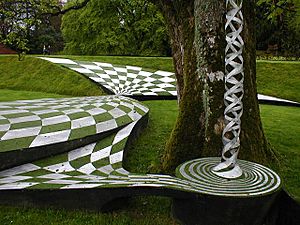Charles Jencks facts for kids
Quick facts for kids
Charles Alexander Jencks
|
|
|---|---|
 |
|
| Born | 21 June 1939 |
| Died | 13 October 2019 |
| Occupation | American cultural theorist, Historian |
Charles Alexander Jencks (born June 21, 1939 – died October 13, 2019) was an American thinker, landscape designer, and expert on architecture. He also helped start the Maggie’s Cancer Care Centres. Jencks wrote over thirty books and became well-known in the 1980s for his ideas about Postmodernism. He spent a lot of time creating special landscapes, especially in Scotland. These include the famous Garden of Cosmic Speculation and earthworks at Jupiter Artland near Edinburgh. Another big project, Crawick Multiverse, opened in 2015 near Sanquhar.
Contents
Early Life and Learning
Charles Alexander Jencks was born in Baltimore, Maryland, on June 21, 1939. His father was a composer. Charles went to Harvard University and earned a degree in English literature in 1961. He then studied architecture and got another degree from the Harvard Graduate School of Design in 1965.
In 1965, Jencks moved to the United Kingdom. He later earned his PhD in architectural history in 1970 from University College London. His studies helped him write his book Modern Movements in Architecture (1973), where he looked at 20th-century architecture in new ways.
Designing Buildings
Jencks' first building design was a small studio in the woods called The Garagia Rotunda. It was made from simple, ready-made parts. He wrote a book called Adhocism – the Case for Improvisation (1971) about using everyday materials in creative ways.
Jencks also designed his own home in London with his wife, Maggie Keswick, and other architects. He called this house "Thematic House" because it explored different ideas and themes in its design.
Maggie's Centres: Helping Others
After his second wife, Maggie Keswick Jencks, passed away in 1995, Charles Jencks helped create the Maggie's Cancer Caring Centres. These centres offer support and help to people with cancer and their families. They are designed to be welcoming and beautiful places, often located near hospitals. The goal is to provide a comfortable and uplifting environment where people can find social and psychological support during a difficult time. The architecture, gardens, and art in these centres are all chosen to help patients and their caregivers feel better.
Amazing Landscape Designs
Jencks started designing landscapes when Maggie asked him to work on their family home and garden in Scotland. This led to the Garden of Cosmic Speculation, which opened in 2003. This garden has twenty different areas, each designed around ideas from science and nature, like the DNA garden, Quark Walk, and Fractal terrace.
He created more unique landforms and sculptures in places like Edinburgh, Milan, New York, and South Korea. These works often combine ideas from science, art, and nature.
The Garden of Cosmic Speculation
The Garden of Cosmic Speculation was started in 1988 and was dedicated to Jencks' late wife. Jencks, his wife, scientists, and friends designed the garden based on natural and scientific ideas. Jencks wanted to celebrate nature but also include elements from modern science.
The garden has beautiful plants, but it also uses new tools and materials to show ideas about the universe. Just like old gardens in Japan or France were like small versions of the universe, this garden shows the evolution of our world. Jencks believed that gardens can also tell a story about the owner's life, including happy times and sad ones.
He thought that modern science could inspire great creativity because it helps us understand the universe and see patterns of beauty. His landscape work often includes hidden messages and symbols that make visitors think about the world around them, from the smallest details to the biggest ideas.
The Crawick Multiverse
Starting in 2010, Jencks worked on the Crawick Multiverse, a large 55-acre site in southwest Scotland. This project, which opened in 2015, also explores ideas from science and the universe through its landforms.
Jencks became a leading figure in British landscape architecture. His designs were inspired by scientific concepts like black holes, fractals, genetics, and chaos theory.
Writing About Architecture
Jencks wrote many books about architecture. In his book The Language of Post-Modern Architecture (1977), he talked about how architecture changed from "modern" to "postmodern." He explained that modern buildings often used simple, straight lines and looked like office buildings. But postmodern architecture used shapes and ideas inspired by the human body, cities, and nature.
He also wrote about why certain buildings become "iconic" or famous. He believed that these buildings are often created to attract attention and money, and they use special symbols to give them deeper meaning.
Other Creative Projects
Jencks was also a furniture designer and sculptor. He created DNA sculptures for places like Kew Gardens in 2003 and Cambridge University in 2005.
Some of his other notable works include:
- The Thematic House (with Terry Farrell), London, 1979–84.
- Landform Ueda, Gallery of Modern Art, Edinburgh, 1999–2002.
- The DNA Spiral, Centre for Life, Newcastle upon Tyne, May 2000.
- Wu Chi, Olympic Forest Park, Beijing, 2008.
- Cells of Life, Jupiter Artland, Bonnington House, Kirknewton, near Edinburgh, 2003–2010.
- Northumberlandia, The Lady of the North, Cramlington, 2005–2012.
On Television
Jencks appeared on many TV shows in the U.S. and UK. He also wrote two TV films for the BBC about famous architects like Le Corbusier and Frank Lloyd Wright. His TV work helped share his ideas about architecture and design with a wider audience.
Images for kids
See also
 In Spanish: Charles Jencks para niños
In Spanish: Charles Jencks para niños






